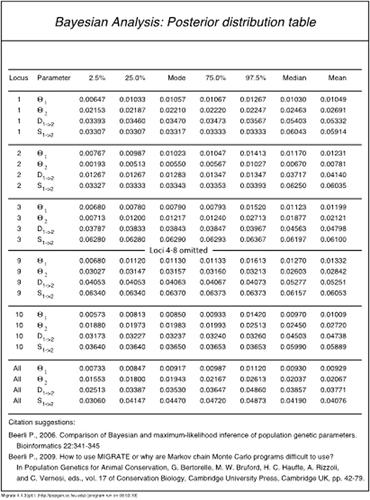下载PDF
{"title":"与迁移的群体遗传推断","authors":"Peter Beerli, Somayeh Mashayekhi, Marjan Sadeghi, Marzieh Khodaei, Kyle Shaw","doi":"10.1002/cpbi.87","DOIUrl":null,"url":null,"abstract":"<p>Many evolutionary biologists collect genetic data from natural populations and then need to investigate the relationship among these populations to compare different biogeographic hypotheses. MIGRATE, a useful tool for exploring relationships between populations and comparing hypotheses, has existed since 1998. Throughout the years, it has steadily improved in both the quality of algorithms used and in the efficiency of carrying out those calculations, thus allowing for a larger number of loci to be evaluated. This efficiency has been enhanced, as MIGRATE has been developed to perform many of its calculations concurrently when running on a computer cluster. The program is based on the coalescence theory and uses Bayesian inference to estimate posterior probability densities of all the parameters of a user-specified population model. Complex models, which include migration and colonization parameters, can be specified. These models can be evaluated using marginal likelihoods, thus allowing a user to compare the merits of different hypotheses. The three presented protocols will help novice users to develop sophisticated analysis techniques useful for their research projects. © 2019 The Authors.</p><p><b>Basic Protocol 1</b>: First steps with MIGRATE</p><p><b>Basic Protocol 2</b>: Population model specification</p><p><b>Basic Protocol 3</b>: Prior distribution specification</p><p><b>Basic Protocol 4</b>: Model selection</p><p><b>Support Protocol 1</b>: Installing the program MIGRATE</p><p><b>Support Protocol 2</b>: Installation of parallel MIGRATE</p>","PeriodicalId":10958,"journal":{"name":"Current protocols in bioinformatics","volume":"68 1","pages":""},"PeriodicalIF":0.0000,"publicationDate":"2019-10-24","publicationTypes":"Journal Article","fieldsOfStudy":null,"isOpenAccess":false,"openAccessPdf":"https://sci-hub-pdf.com/10.1002/cpbi.87","citationCount":"43","resultStr":"{\"title\":\"Population Genetic Inference With MIGRATE\",\"authors\":\"Peter Beerli, Somayeh Mashayekhi, Marjan Sadeghi, Marzieh Khodaei, Kyle Shaw\",\"doi\":\"10.1002/cpbi.87\",\"DOIUrl\":null,\"url\":null,\"abstract\":\"<p>Many evolutionary biologists collect genetic data from natural populations and then need to investigate the relationship among these populations to compare different biogeographic hypotheses. MIGRATE, a useful tool for exploring relationships between populations and comparing hypotheses, has existed since 1998. Throughout the years, it has steadily improved in both the quality of algorithms used and in the efficiency of carrying out those calculations, thus allowing for a larger number of loci to be evaluated. This efficiency has been enhanced, as MIGRATE has been developed to perform many of its calculations concurrently when running on a computer cluster. The program is based on the coalescence theory and uses Bayesian inference to estimate posterior probability densities of all the parameters of a user-specified population model. Complex models, which include migration and colonization parameters, can be specified. These models can be evaluated using marginal likelihoods, thus allowing a user to compare the merits of different hypotheses. The three presented protocols will help novice users to develop sophisticated analysis techniques useful for their research projects. © 2019 The Authors.</p><p><b>Basic Protocol 1</b>: First steps with MIGRATE</p><p><b>Basic Protocol 2</b>: Population model specification</p><p><b>Basic Protocol 3</b>: Prior distribution specification</p><p><b>Basic Protocol 4</b>: Model selection</p><p><b>Support Protocol 1</b>: Installing the program MIGRATE</p><p><b>Support Protocol 2</b>: Installation of parallel MIGRATE</p>\",\"PeriodicalId\":10958,\"journal\":{\"name\":\"Current protocols in bioinformatics\",\"volume\":\"68 1\",\"pages\":\"\"},\"PeriodicalIF\":0.0000,\"publicationDate\":\"2019-10-24\",\"publicationTypes\":\"Journal Article\",\"fieldsOfStudy\":null,\"isOpenAccess\":false,\"openAccessPdf\":\"https://sci-hub-pdf.com/10.1002/cpbi.87\",\"citationCount\":\"43\",\"resultStr\":null,\"platform\":\"Semanticscholar\",\"paperid\":null,\"PeriodicalName\":\"Current protocols in bioinformatics\",\"FirstCategoryId\":\"1085\",\"ListUrlMain\":\"https://onlinelibrary.wiley.com/doi/10.1002/cpbi.87\",\"RegionNum\":0,\"RegionCategory\":null,\"ArticlePicture\":[],\"TitleCN\":null,\"AbstractTextCN\":null,\"PMCID\":null,\"EPubDate\":\"\",\"PubModel\":\"\",\"JCR\":\"Q1\",\"JCRName\":\"Biochemistry, Genetics and Molecular Biology\",\"Score\":null,\"Total\":0}","platform":"Semanticscholar","paperid":null,"PeriodicalName":"Current protocols in bioinformatics","FirstCategoryId":"1085","ListUrlMain":"https://onlinelibrary.wiley.com/doi/10.1002/cpbi.87","RegionNum":0,"RegionCategory":null,"ArticlePicture":[],"TitleCN":null,"AbstractTextCN":null,"PMCID":null,"EPubDate":"","PubModel":"","JCR":"Q1","JCRName":"Biochemistry, Genetics and Molecular Biology","Score":null,"Total":0}
引用次数: 43
引用
批量引用
Population Genetic Inference With MIGRATE
Many evolutionary biologists collect genetic data from natural populations and then need to investigate the relationship among these populations to compare different biogeographic hypotheses. MIGRATE, a useful tool for exploring relationships between populations and comparing hypotheses, has existed since 1998. Throughout the years, it has steadily improved in both the quality of algorithms used and in the efficiency of carrying out those calculations, thus allowing for a larger number of loci to be evaluated. This efficiency has been enhanced, as MIGRATE has been developed to perform many of its calculations concurrently when running on a computer cluster. The program is based on the coalescence theory and uses Bayesian inference to estimate posterior probability densities of all the parameters of a user-specified population model. Complex models, which include migration and colonization parameters, can be specified. These models can be evaluated using marginal likelihoods, thus allowing a user to compare the merits of different hypotheses. The three presented protocols will help novice users to develop sophisticated analysis techniques useful for their research projects. © 2019 The Authors.
Basic Protocol 1 : First steps with MIGRATE
Basic Protocol 2 : Population model specification
Basic Protocol 3 : Prior distribution specification
Basic Protocol 4 : Model selection
Support Protocol 1 : Installing the program MIGRATE
Support Protocol 2 : Installation of parallel MIGRATE



